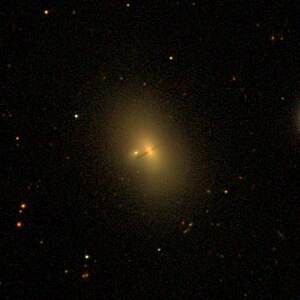NGC 810
| Galaxy NGC 810 |
|
|---|---|

|
|
| SDSS recording | |
| AladinLite | |
| Constellation | Aries |
|
Position equinox : J2000.0 , epoch : J2000.0 |
|
| Right ascension | 2 h 5 m 28.528 s |
| declination | + 13 ° 15 ′ 5.45 ″ |
| Appearance | |
| Morphological type | E. |
| Brightness (visual) | 13.9 likes |
| Brightness (B-band) | 14.9 mag |
| Angular expansion | 1.29 ′ × 1.01 ′ |
| Surface brightness | 14.8 mag / arcmin² |
| Physical data | |
| Redshift | 0.025568 +/- 0.000130 |
| Radial velocity | 7665 +/- 39 km / s |
|
Stroke distance v rad / H 0 |
(346 ± 24) x 10 6 ly (106.0 ± 7.4) Mpc |
| history | |
| discovery | Édouard Jean-Marie Stephan |
| Discovery date | December 11, 1871 |
| Catalog names | |
| NGC 810 • UGC 1583 • PGC 7965 • CGCG 438-024 • MCG + 02-06-26 • 2MASX J02052852 + 1315054 • GC 5213 • | |
NGC 810 is an elliptical galaxy in the constellation Aries , which is approximately 346 million light years from the Milky Way . NGC 810 and PGC 3126708 together form an optical galaxy pair . It was discovered on December 11, 1871 by the French astronomer Édouard Jean-Marie Stephan .
Web links
- SIMBAD Astronomical Database
- Auke Slotegraaf: NGC 810. Deep Sky Observer's Companion, accessed on March 22, 2016 (English).
- NGC 810. DSO Browser, accessed March 22, 2016 .
